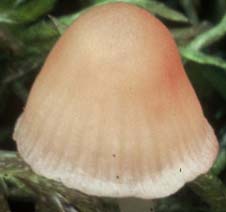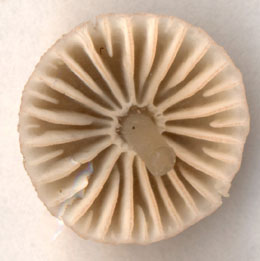Habitat
Many Mycenas have specific habitat demands. Mycena
strobilicola grows exclusively on Picea cones; M. mucor on fallen oak leaves; M. belliae on standing stalks of Phragmites just above the
stemnant water; M. terena on fallen Salix leaves; M. juniperina on bark of Juniperus; M. riparia on monocot plants in wetland areas; M. lohwagii on fern rhizomes, and M. alba on the bark of deciduous trees - just to mention a few.
Some species, like M. inclinata, M. tintinnabulum,
and M. laevigata grow more or less cespitose or
fasciculate, while others grow gregarious or in small groups.
Pileus
 The
size and the colours of the carpophore are, of coarse, important
characters. The shape of the pileus may also be of diagnostic
importance. Most Mycenas have a conical, bell-shaped
pileus, flattening with age. Some are more or less hemispherical
in young specimens. A few species sometimes show an umbonate
pileus (e. g. M. pura) or a distinct papilla (e.
g. M. oligophylla), and some may even be somewhat
depressed in the centre (e. g. M. belliae). The
size and the colours of the carpophore are, of coarse, important
characters. The shape of the pileus may also be of diagnostic
importance. Most Mycenas have a conical, bell-shaped
pileus, flattening with age. Some are more or less hemispherical
in young specimens. A few species sometimes show an umbonate
pileus (e. g. M. pura) or a distinct papilla (e.
g. M. oligophylla), and some may even be somewhat
depressed in the centre (e. g. M. belliae).
The surface of the pileus should be noticed. Most often
the pileus is pruinose, becoming more or less glabrous.
Sometimes it is more conspicuously puberoulous, or even
floccose (e. g. M. adscendens). In some species
(e. g. M. vulgaris, M. stylobates, M.
epipterygia, M. amicta) the pileus is covered
with a viscid, separable pellicle.
Lamellae
The number of lamellae reaching the stipe is of great importance.
 In
most Mycenas the lamellae are ascending and narrowly adnate.
In some species the lamellae are horizontal to arcuate (e.
g. M. vulgaris, M. picta, M. clavicularis).
The attachment may be broadly adnate (e. g. M. alba)
as well as far decurrent (e. g. M. agrestis). In
some species the lamellae are almost free (e. g. M.
bulbosa), and in at least one species they can be completely
absent, or rarely fully developed, only showing as low ridges
and evanescent before reaching the margin of the pileus
(M. oligophylla). In
most Mycenas the lamellae are ascending and narrowly adnate.
In some species the lamellae are horizontal to arcuate (e.
g. M. vulgaris, M. picta, M. clavicularis).
The attachment may be broadly adnate (e. g. M. alba)
as well as far decurrent (e. g. M. agrestis). In
some species the lamellae are almost free (e. g. M.
bulbosa), and in at least one species they can be completely
absent, or rarely fully developed, only showing as low ridges
and evanescent before reaching the margin of the pileus
(M. oligophylla).
The colour of the lamellae is important, and in some species
the edge is coloured differently than the lamella face (e.
g. M. rubromarginata, M. olivaceomarginata, M. aurantiomarginata, M. flavescens).
In some species the lamellar edge is covered by an elastic,
gelatinous thread (e. g. M. bulbosa, M. epipterygia, M. vulgaris).
Stipe
It is important to notice the length and the width of the stipe. Even more important is the colour. The surface of the stipe should also be taken into account. The surface may be pruinose to glabrous, as in most species, while it may also be glutinous to viscid (e. g. M. clavicularis, M. vulgaris, M. epipterygia). It may also be of importance if the stipe is fragile or more tough.
In some species the stipe contains a coloured fluid (e.
g. white in M. galopus; watery white in M.
erubescens; red-brown in M. haematopus and M. sanguinolenta; orange red in M. crocata).
Sometimes it may also be important how the stipe is attached
to the substratum. In some species (e. g. M. stylobates, M. mucor, M.
bulbosa) the stipe is springing from a
basal disc.
Odour
The smell is often an unreliable character, although it
may be quite important. The smell in most Mycenas is rather inconstant, while it is also a subjective character.
The majority of the species have no specific odour. Quite
a few have a nitrous smell (e. g. M. stipata, M.
silvae-nigrae, M. leptocephala, M. viridimarginata, M. ustalis, M. capillaripes), and others
smell like iodoform when drying out (e. g. M. metata, M. filopes). One species (M. flavescens)
has a strong odour of raw potatoes when crushed. M.
cinerella and a few other species have a farinaceous
odour. In the Mycena pura group there are several
species with a strong raphanoid odour.
Taste
The taste is not important in Mycena. Sometimes
the odour is better experienced in the taste. In M.
galericulata the odour is often said to be farinaceous.
That may be hard to recognize. The taste, however, is almost
always distinctly farinaceous.
M. erubescens has a unique, bitter taste (of kinin).
Go to microscopic characters |